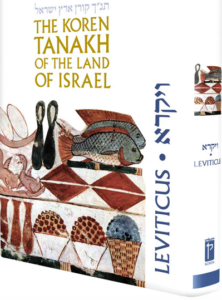By Rabbi Dr. Israel Drazin

BOCA RATON, Florida — Koren Press’ “The Koren Tanakh of the Land of Israel – Leviticus” follows its predecessors on the Biblical books Exodus and Samuel as a third outstanding biblical commentary. It contains a wealth of scholarly information written in an easy-to-read and interesting — even fascinating — fashion by more than a dozen and a half academic and Modern Orthodox rabbinic scholars. It is eye- and mind-opening because the book of Leviticus deals with many matters no longer part of Judaism other than the moral and practical teachings underlying sacrifices and temple Priestly and Levitical services. The many comments and essays on Moses’ sanctuary, the later temples, and temples of ancient Near Eastern countries are by scholars who are experts in the ancient Near East.
The translation of the Torah text by the late Rabbi Lord Jonathan Sacks follows the suggestion of Maimonides to his translator, who translated his Arabic “Guide for the Perplexed” to Hebrew: Do not translate literally, word for word, because what makes sense in one language often does not make sense when copied literally in another language. Find the intent in the original and make the translation clear by inserting it, such as Sacks’ rendering vehiktir in 1:9, which literally means “turn into smoke,” as “burn it all.”
 Among much else, the volume gives an extensive introduction to the book of Leviticus, has a very informative glossary of a dozen pages, devotes close to three dozen pages listing by subject matter books and articles readers can use to research subjects that interest them for more detailed information, a half dozen pages with as many as 40 names on each page of the sources of the multiple colorful images in the book, about a dozen pages of index, and much more. It comments on and explains such things as archaeology, Egyptology, the near east, flora and fauna, geography, halakha, repentance in Leviticus and Numbers versus the ancient Near East, as well as describing Moses’ tabernacle in the desert to the temple in Jerusalem and pagan temples, the theory of sacrifices, the “holiness code” in the ancient Near East, the timeline of Israel in relation to Egypt, Mesopotamia, Hittites, Greece, Rome, and more.
Among much else, the volume gives an extensive introduction to the book of Leviticus, has a very informative glossary of a dozen pages, devotes close to three dozen pages listing by subject matter books and articles readers can use to research subjects that interest them for more detailed information, a half dozen pages with as many as 40 names on each page of the sources of the multiple colorful images in the book, about a dozen pages of index, and much more. It comments on and explains such things as archaeology, Egyptology, the near east, flora and fauna, geography, halakha, repentance in Leviticus and Numbers versus the ancient Near East, as well as describing Moses’ tabernacle in the desert to the temple in Jerusalem and pagan temples, the theory of sacrifices, the “holiness code” in the ancient Near East, the timeline of Israel in relation to Egypt, Mesopotamia, Hittites, Greece, Rome, and more.
A history of the surrounding nations and their customs is included. There are colorful pictures on virtually every page, many maps, charts, dates, articles on language, what is the Masoretic text, comparing the Torah to ancient Near East law collections, pictures of the Tabernacle and items used during its service, and detailed discussions on subjects such as God receiving “a pleasing aroma,” the ancient use of salt, the use of the number seven in Near Eastern rituals, the significance of horns on the altar, making atonement, oaths, the eternal flame, divine revelation, why raise hands to bless people, and much more.
Everyone reading the 299 pages of this excellent book or even browsing through it, whether Jew or non-Jew, even if the reader has a university education on the Bible or attended Orthodox yeshivot for many years, will benefit from this book a thousand-fold by learning more about the Bible, what it is teaching, its history, its comparison with the teachings of other ancient cultures, and much more.